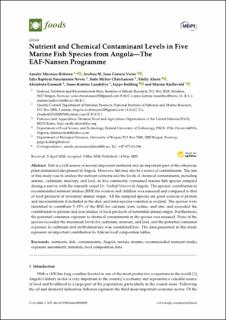Nutrient and chemical contaminant levels in five marine fish species from Angola—The EAF-Nansen programme
Reksten, Amalie Moxness; Victor, Avelina M. João Correia; Neves, Edia Baptista Nascimento; Christiansen, Sofie Myhre; Ahem, Molly; Uzomah, Abimbola; Lundebye, Anne-Katrine; Kolding, Jeppe; Kjellevold, Marian
Journal article, Peer reviewed
Published version

Åpne
Permanent lenke
https://hdl.handle.net/11250/2757978Utgivelsesdato
2020Metadata
Vis full innførselSamlinger
- Department of Biological Sciences [2216]
- Registrations from Cristin [9489]
Sammendrag
Fish is a rich source of several important nutrients and an important part of the otherwise plant-dominated diet present in Angola. However, fish may also be a source of contaminants. The aim of this study was to analyse the nutrient contents and the levels of chemical contaminants, including arsenic, cadmium, mercury, and lead, in five commonly consumed marine fish species sampled during a survey with the research vessel Dr. Fridtjof Nansen in Angola. The species’ contribution to recommended nutrient intakes (RNI) for women and children was assessed and compared to that of food products of terrestrial animal origin. All the sampled species are good sources of protein and micronutrients if included in the diet, and inter-species variation is evident. The species were identified to contribute 5–15% of the RNI for calcium, iron, iodine, and zinc and exceeded the contribution to protein and iron intakes of food products of terrestrial animal origin. Furthermore, the potential consumer exposure to chemical contaminants in the species was assessed. None of the species exceeded the maximum levels for cadmium, mercury, and lead, and the potential consumer exposure to cadmium and methylmercury was considered low. The data presented in this study represent an important contribution to African food composition tables.
